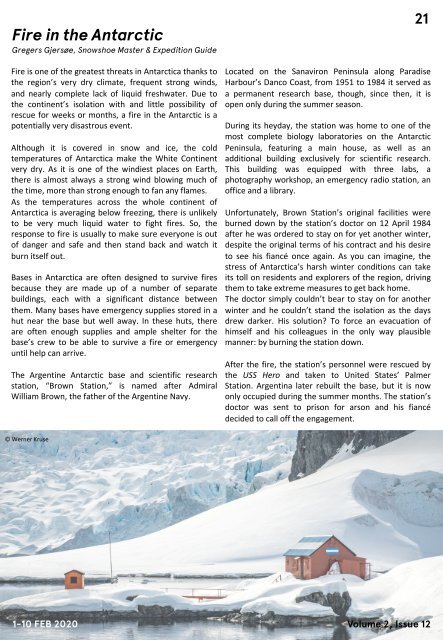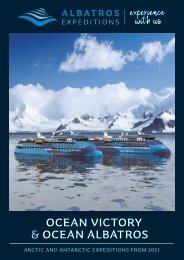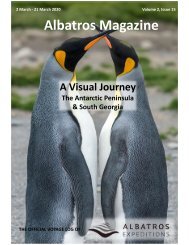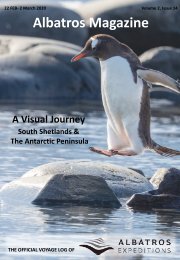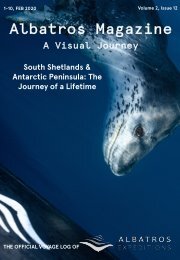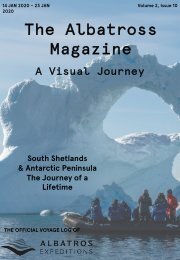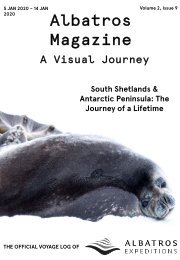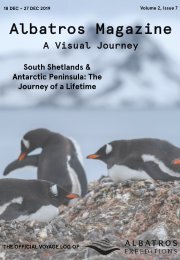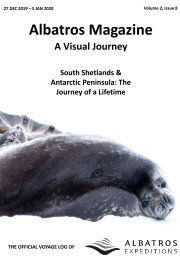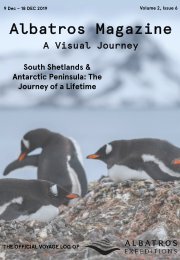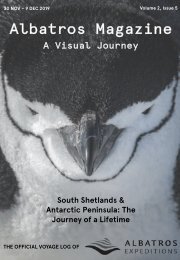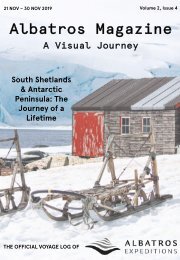Antarctic Peninsula and Polar Circle 2020 Feb 10 2020 -13
Create successful ePaper yourself
Turn your PDF publications into a flip-book with our unique Google optimized e-Paper software.
Fire in the <strong>Antarctic</strong><br />
Gregers Gjersøe, Snowshoe Master & Expedition Guide<br />
Fire is one of the greatest threats in <strong>Antarctic</strong>a thanks to<br />
the region’s very dry climate, frequent strong winds,<br />
<strong>and</strong> nearly complete lack of liquid freshwater. Due to<br />
the continent’s isolation with <strong>and</strong> little possibility of<br />
rescue for weeks or months, a fire in the <strong>Antarctic</strong> is a<br />
potentially very disastrous event.<br />
Although it is covered in snow <strong>and</strong> ice, the cold<br />
temperatures of <strong>Antarctic</strong>a make the White Continent<br />
very dry. As it is one of the windiest places on Earth,<br />
there is almost always a strong wind blowing much of<br />
the time, more than strong enough to fan any flames.<br />
As the temperatures across the whole continent of<br />
<strong>Antarctic</strong>a is averaging below freezing, there is unlikely<br />
to be very much liquid water to fight fires. So, the<br />
response to fire is usually to make sure everyone is out<br />
of danger <strong>and</strong> safe <strong>and</strong> then st<strong>and</strong> back <strong>and</strong> watch it<br />
burn itself out.<br />
Bases in <strong>Antarctic</strong>a are often designed to survive fires<br />
because they are made up of a number of separate<br />
buildings, each with a significant distance between<br />
them. Many bases have emergency supplies stored in a<br />
hut near the base but well away. In these huts, there<br />
are often enough supplies <strong>and</strong> ample shelter for the<br />
base’s crew to be able to survive a fire or emergency<br />
until help can arrive.<br />
The Argentine <strong>Antarctic</strong> base <strong>and</strong> scientific research<br />
station, “Brown Station,” is named after Admiral<br />
William Brown, the father of the Argentine Navy.<br />
21<br />
Located on the Sanaviron <strong>Peninsula</strong> along Paradise<br />
Harbour’s Danco Coast, from 1951 to 1984 it served as<br />
a permanent research base, though, since then, it is<br />
open only during the summer season.<br />
During its heyday, the station was home to one of the<br />
most complete biology laboratories on the <strong>Antarctic</strong><br />
<strong>Peninsula</strong>, featuring a main house, as well as an<br />
additional building exclusively for scientific research.<br />
This building was equipped with three labs, a<br />
photography workshop, an emergency radio station, an<br />
office <strong>and</strong> a library.<br />
Unfortunately, Brown Station’s original facilities were<br />
burned down by the station’s doctor on 12 April 1984<br />
after he was ordered to stay on for yet another winter,<br />
despite the original terms of his contract <strong>and</strong> his desire<br />
to see his fiancé once again. As you can imagine, the<br />
stress of <strong>Antarctic</strong>a’s harsh winter conditions can take<br />
its toll on residents <strong>and</strong> explorers of the region, driving<br />
them to take extreme measures to get back home.<br />
The doctor simply couldn’t bear to stay on for another<br />
winter <strong>and</strong> he couldn’t st<strong>and</strong> the isolation as the days<br />
drew darker. His solution? To force an evacuation of<br />
himself <strong>and</strong> his colleagues in the only way plausible<br />
manner: by burning the station down.<br />
After the fire, the station’s personnel were rescued by<br />
the USS Hero <strong>and</strong> taken to United States’ Palmer<br />
Station. Argentina later rebuilt the base, but it is now<br />
only occupied during the summer months. The station’s<br />
doctor was sent to prison for arson <strong>and</strong> his fiancé<br />
decided to call off the engagement.<br />
© Werner Kruse<br />
1-<strong>10</strong> FEB <strong>2020</strong><br />
Volume 2, Issue 12


